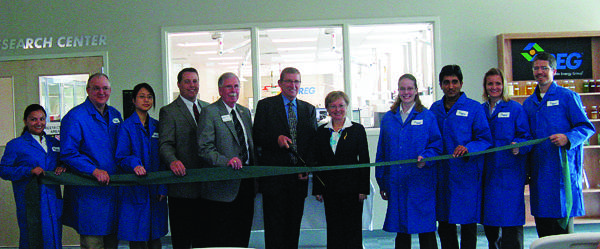New lab battles energy crisis with science

New lab battles energy crisis with science
August 2, 2009
A new laboratory at Renewable Energy Group, 416 S. Bell Ave., may help biodiesel become more competitive as an alternative to oil.
The lab opened at the Group’s headquarters July 28 and will perform research on new biodiesel feedstocks — the commodities from which biodiesel is produced.
Today, biodiesel comes mainly from soybean oil or animal fats, said Alicia Clancy, corporate affairs coordinator with Renewable Energy Group.
Since the industry relies heavily on these products, the price of biodiesel is linked to commodity prices, and biodiesel manufacturers are often at the mercy of the market. If feedstock prices increase, so does the price of biodiesel, making it tough to compete with oil-derived alternatives.
The industry has found itself in an increasingly harder place as feedstock prices have risen and oil prices have fallen. Clancy said by some estimates, today’s U.S. biodiesel industry is running at only 15 to 20 percent of capacity.
Manufacturers hope to change the economics by diversifying into different feedstocks.
“We can make biodiesel out of basically any fat or oil,” Clancy said.
If manufacturers can commercialize processes for producing biodiesel from other sources, they will have the freedom to choose whichever commodity happens to be cheapest at any given point in time.
That’s where the energy group’s new lab comes in. Part of the lab’s purpose is to test a wide variety of oils for potential biodiesel production.
As an intern at Renewable Energy Group this past summer, Marlen Valverde, graduate student in chemistry, helped track down some of the 37 oils that the group will initially test.
“Some of these feedstocks came from India, from China,” Valverde said. “Part of my project was to get some of those oils here.”
Along with coffee, hemp and mustard oil, the lab will test more exotic materials, like the oil of the neem tree, an evergreen native to southern Asia.
One of the most promising possibilities is oil extracted from algae.
“Algae is exciting because of the large volumes of oil [that can be produced],” Clancy said.
Whereas a soybean field may be able to produce 50 gallons of oil per acre, an acre of algae grown through aquaculture may yield up to 15,000 gallons of oil, Clancy said.
Another promising possibility is oil, which can be extracted from the leftovers of ethanol production.
“You can basically get two renewable fuels out of a single kernel of corn,” Clancy said.
Some of these feedstocks, such as algae, have already been used to make biodiesel in a lab — the trick is standardizing and commercializing the method.
“They want to make biodiesel with all these feedstocks with the same process,” Valverde said.
Now hired full-time as a chemist, Valverde’s work could help make this happen and could help predict the viability of additional feedstocks in the future.
“Based on the fatty acid profile [of an oil], we can predict what are the properties of that biodiesel,” Valverde said.





